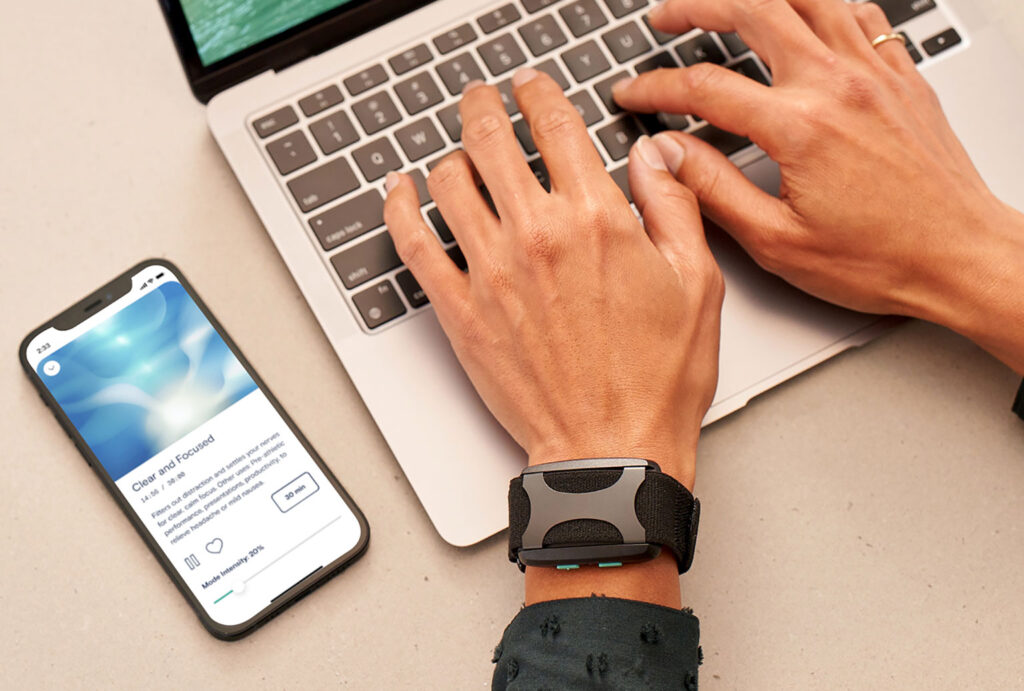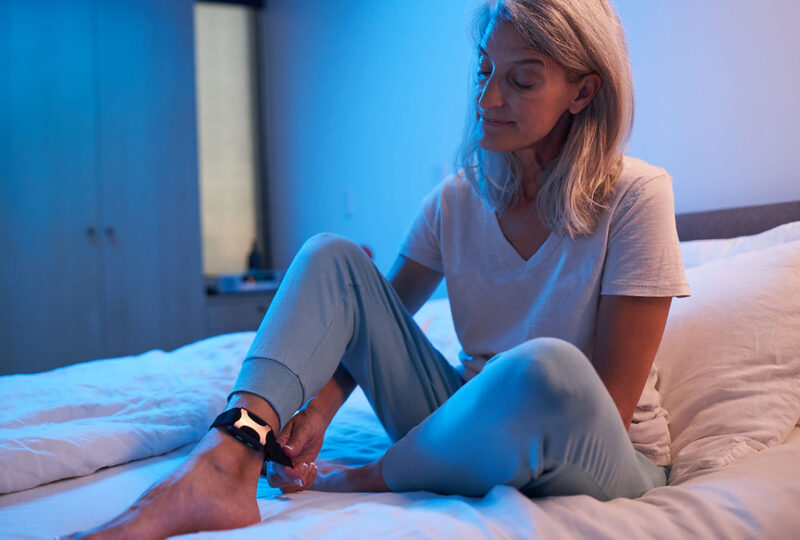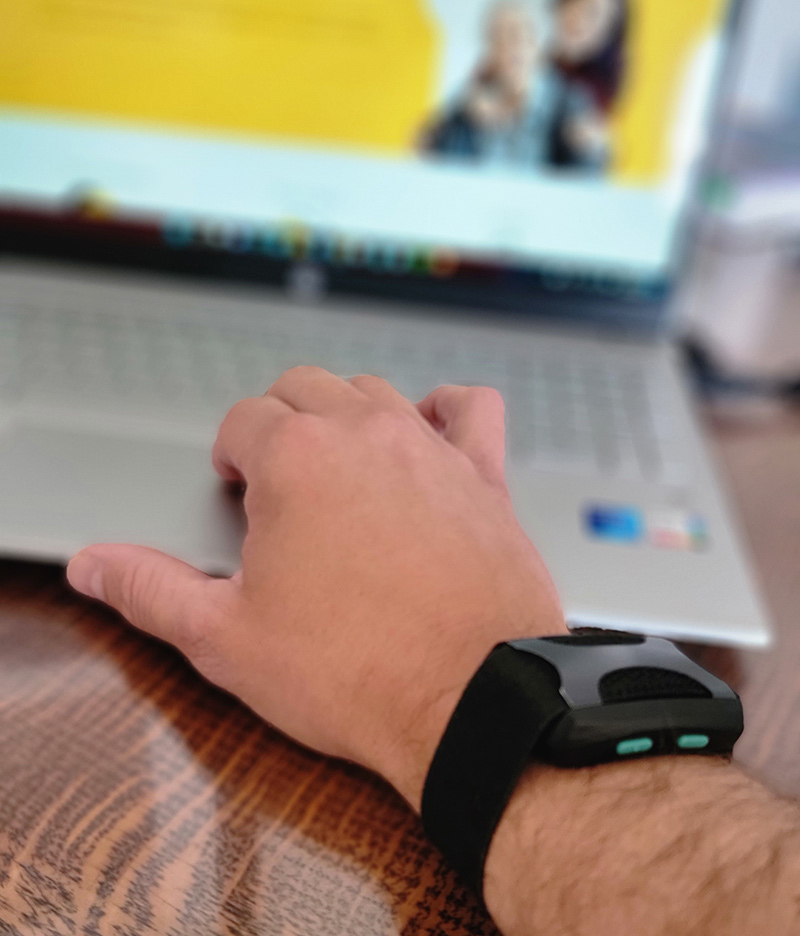Our nervous systems really take a beating from just constantly being, well, nervous. Nervous feelings, nervous energy, anxiety, stress—it seems many of us are never more than one step away from a full-on fight-or-flight crisis. And as many caregivers can attest, chronic stress takes a heavy toll on our energy, mood, sleep and certainly our relationships.
In coping with my own stress, I’ve realized I’m not a smartwatch or Fitbit kind of guy. For me, a tiny device taking constant measurements, telling me how badly I slept or how short I fell of my walking goals, only exacerbates the stress I’m hoping to soothe.
A new type of wearable, however, piqued my interest—not for what it takes but for what it gives.
Apollo is a wearable designed to specifically target your nervous system—all from a band you can wear around your wrist or ankle (or from a clip worn next to the body attached to your clothes). Developed by neuroscientists and doctors at Pittsburgh-based Apollo Neuroscience, its claims of “touch therapy” using “silent, soothing vibrations” had me intrigued.
“As it strengthens and rebalances your autonomic nervous system … you’re building your resilience to stress,” the website reads. “So, you spend less time in fight-or-flight mode and get more time to rest and digest. Over time, your body learns to recover from stress more quickly, so you can relax, sleep better, and find deep, meaningful focus—anytime and anywhere.”
I looked through the available colors, chose the black one, and decided to see what it could do for me.
Stress relief and better sleep that’s research-based
My wrist is subtly vibrating as I type this. The Apollo is currently strapped to my right arm, the watch-sized rectangle pressed against my wrist. It’s currently set to the “Clear & Focused” mode as I concentrate on my work.
Unlike a lot of the tech gadgets available, Apollo was born in the lab as a product of the research of Dr. David Rabin, MD, PhD, at the University of Pittsburgh’s Cognitive-Affective Neuroscience and Development Lab. The device has undergone six clinical trials (with additional trials underway), which yielded some very real results for participants:
- 40% less stress and feelings of anxiety
- 11% increase in heart rate variability
- Up to 25% more focus and concentration
- 10% quicker physical recovery
Those are all great, but I was more interested in how it could help me sleep. The company studied more than 500 users who wore the Apollo at least three hours a day, five days a week and found some improvement:
- 19% increase in deep sleep
- 14% increase in REM sleep
I’ll admit that just like my healthy eating habits, my Apollo use has been wildly inconsistent. But the impact it made on my sleep was almost immediate. It’s easy to write off perceived effects of some of the other modes as psychosomatic, but you can tell when you wake up if you’ve slept well. After only a couple of nights, my stretches of deep sleep were longer, and I felt more rested in the morning. The sleep mode is a gentle vibration on my wrist that has proven to be surprisingly comforting, like a calm co-pilot on my journey to solid sleep—one that’s safe, noninvasive and prevents me from having to take another Advil PM.
“High-quality sleep is essential,” Rabin said. “But we’re evolved to not be able to turn on our sleeping system when we are under real or perceived threat. Many of us experience stress much of the day, and we live in a state of fight-or-flight. With Apollo Neuro, you’re finally able to access sleep and relaxed states when you need it most.”
Settings for every part of your day
While the Apollo has helped me the most with sleep, I’ve also benefited from some of the other modes. The “Rebuild and Recover” has been a nice boost on those days when I’ve felt under the weather (often self-inflicted), and the “Social and Open” setting – which promises it “elevates mood and energy to relieve stress in social situations” – has helped me stay present with others and, frankly, feel more outgoing. “Energy and Wake Up” has already proven to be a nice companion to my morning coffee.

Other settings I’ve not used much but plan on trying are “Relax and Unwind” and “Meditation and Mindfulness.”
All the modes allow you to select the intensity of the vibrations and how long they last, and the accompanying app that controls the device also offers recommendations to help you get started.
While the device needs to be charged every couple of days (or more often), and the app can be a little slow to connect to the Apollo, the benefits far outweigh any of the inconveniences. After all, it’s nice to know I’m doing something to tamp down my stress and give my nervous system a little love without worrying about any negative side effects.
I’m still not a Fitbit guy, and my regular old analog watch isn’t leaving my left wrist. But on my right? This new wearable may just have staked its claim.


